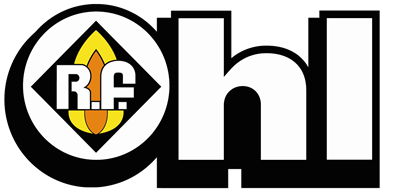Propane Heat Keeps Kunkletown PA Home Warm During Power Outages
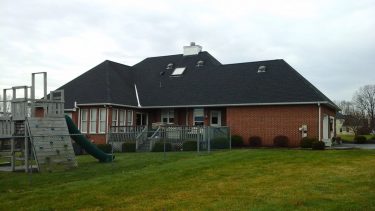 Power outages are frequent in rural areas. Kunkletown, PA is no exception. And while they’re inconvenient for everyone, it’s especially rough for people with electric heating.
Power outages are frequent in rural areas. Kunkletown, PA is no exception. And while they’re inconvenient for everyone, it’s especially rough for people with electric heating.
That’s why our homeowner in Kunkleltown wanted to make a change. Most of the time, his electric heater worked just fine. But, when the power went out in the dead of winter, he was left out in the cold.
Our homeowner called us for ways to keep his home warm without electricity. We understood the concern well. Many clients come to us concerned about not having heat in the winter.
In these cases, it’s best to go with an option that enables the homeowner to be as independent as possible. Propane heat is a great solution. It’s clean burning and energy-efficient. And, it’s stored in tanks on the property.
Once we settled on a heat source, we also looked at other ways to ensure our homeowner would stay warm all winter.
Problem: A homeowner in Kunkletown, PA wanted an alternative to his electric heat. He experiences frequent power outages where the heater would stop working. He also wanted to upgrade to a more efficient heat source.
Solution: Installed two 100-gallon propane tanks with a 22kw generator, cold weather kit, and generator transfer switch.
Propane Vs Oil Heat
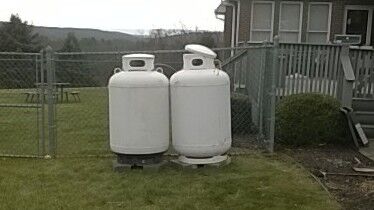 Propane vs oil heat is a common question in rural areas such as those in the Lehigh Valley. That’s in large part because both energy sources are stored in tanks on a person’s property. That means the homeowner isn’t relying on a utility company to pipe in energy on an as-needed basis.
Propane vs oil heat is a common question in rural areas such as those in the Lehigh Valley. That’s in large part because both energy sources are stored in tanks on a person’s property. That means the homeowner isn’t relying on a utility company to pipe in energy on an as-needed basis.
It’s only recently that utility companies have installed natural gas lines in places like Monroe County and other areas in the Lehigh Valley. Even now, however, there’s still the chance that a home may have its service suspended.
It occurs if there’s a problem somewhere in the line. And, we’ve seen how regular power outages affect people with electric heat.
Because of this, propane is an excellent choice for homeowners in place such as Kunkletown. And, the heat source holds other benefits as well.
First, it’s a clean-burning gas — more so than other sources. It produces less carbon monoxide than other combustible fuels. It also emits fewer greenhouse gasses. That’s good for people and the environment overall.
Along with being clean burning, it’s a very efficient heat source. It produces warmer heat than electricity, which means it has to do less work to reach the desired temperature. And, it takes less cubic feet than natural gas to produce the same amount of heat.
When it comes to oil, however, the math is a little fuzzier. On the one hand, an equal amount of heating oil generates more heat than propane. However, the latter produces less waste.
The latter is measured by AFUE, or “Annual Fuel Utilization Efficiency.” This measures how much of the fuel you’re using is actually used to create heat versus how much is lost through the exhaust process.
On average, oil heat has an 85-percent AFUE rating. The remaining 15 percent is wasted. The AFUE rating for our homeowner’s choice is closer to 95 percent.
That efficiency rating, combined with its cleaner combustion and ability to be stored on a homeowner’s property, makes it an attractive choice for homes like these.
Installing Propane Heat In A Rural Home
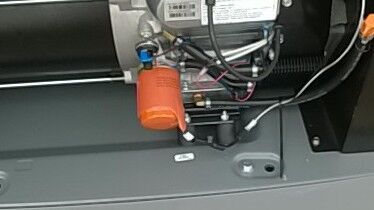 With our homeowner ready to add propane heat to his home, we got to work. It was important that the new system was set up properly. That meant choosing the best equipment for this property and ensuring we installed it safely.
With our homeowner ready to add propane heat to his home, we got to work. It was important that the new system was set up properly. That meant choosing the best equipment for this property and ensuring we installed it safely.
Our homeowner settled on two 100-gallon tanks. This is a little different from most residential jobs.
In many cases, we end up using one 420-pound tank. At that size, it can heat the house while also running appliances such as stoves and clothes dryers.
However, our homeowner only needed it for backup heat. And, his property had a brick ranch home and a barn. So, he didn’t need to store as much. We used two tanks: one for heating and one for a generator. We’ll get into that a little later.
Next, we had to find the best place for the tanks. Our installers had a few requirements to consider. First, the tanks needed to be far enough away from any doors or windows. Then, they had to be at least 10 feet from any ignition points — that is, the place where the gas combusts.
Fortunately, there was a lot of open space on this property. We found a spot more than far enough away to meet all these requirements.
And, it’s out of the way. This way, the tanks don’t draw too much attention to themselves.
Preparing A Backup Heat Source For Winter Weather
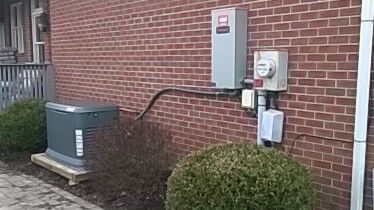 The last step for this job was ensuring the backup heat source would work correctly. After all, this was all in place for an emergency in the dead of winter. It needed to work even under harsh conditions.
The last step for this job was ensuring the backup heat source would work correctly. After all, this was all in place for an emergency in the dead of winter. It needed to work even under harsh conditions.
The first part was a generator. Now, our homeowner could have electricity even when the utility lines are out. Next, we installed a cold weather kit. It helps maintain the temperature for the generator and its components. That way, it would start even in freezing temperatures.
Finally, we added a mobile link for the machine. This is a newer invention that makes using the generator that much more convenient.
The mobile link connects the generator to our homeowner’s phone. Using an app, he can see how long the generator has run, its maintenance history and more. This way, he can keep tabs on what’s happening even when he’s not home.
It’s a modern addition to an older heating solution. But, it’s one that makes the new setup even more powerful.
Are you considering propane for a backup heating and energy solution? Contact us, and we’ll design a system that’s perfect for your home.
